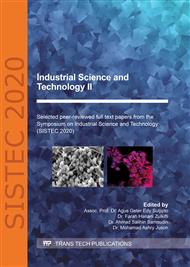p.230
p.236
p.242
p.247
p.252
p.259
p.265
p.273
p.279
Starch Based Film Incorporated with Clitoria ternatea Flower Extracts as pH Indicator
Abstract:
The present study demonstrated the evaluation of starch based film formulated with Clitoria Ternatea flowers extracts which act as pH indicator. Maceration, sonication and infusion extraction were employed to determine the percentage yield of the flower extracts. Extract solutions (1mg/mL) were subjected to UPLC-QTOF/MS in order to detect and identify the chemical constituents of C. ternatea. UV-Vis analysis is done by treating the extracts (4mg/mL) with prepared buffer solution in various pH value ranged (2.0 – 11.0) and the absorbance were observed within a broad range of wavelength (400-700 nm). 100 mL solution of 4g starch, C. ternatea extracts and glycerol (19g plasticizer/100g starch) in distilled water were undergo gelatinization process to form the desired thin film. The functional group presented in the film and raw materials were detected and defined by analyzing through FTIR spectroscopy. From the results, maceration techniques produced the higher yield of extracts with 41.48% compared to sonication and infusion method. Variation colours of C. ternatea solution were displayed in different value of pH. At pH lower than 3, the extract solution illustrated light red to purple in colour while at higher pH value to the more basic pH (4,5,6,7,8 and 9), the colour can be perceived as blue. From the gelatinization process, the blue smooth thin layer of film was produced. FTIR analysis showed that all of samples contain C-O bond (3300 cm-1). Starch based film formulated with C. ternatea as pH indicator can be applied to detect the spoilage of foods in the production of food wrapper and packaging.
Info:
Periodical:
Pages:
252-256
Citation:
Online since:
March 2021
Keywords:
Price:
Сopyright:
© 2021 Trans Tech Publications Ltd. All Rights Reserved
Share:
Citation:


